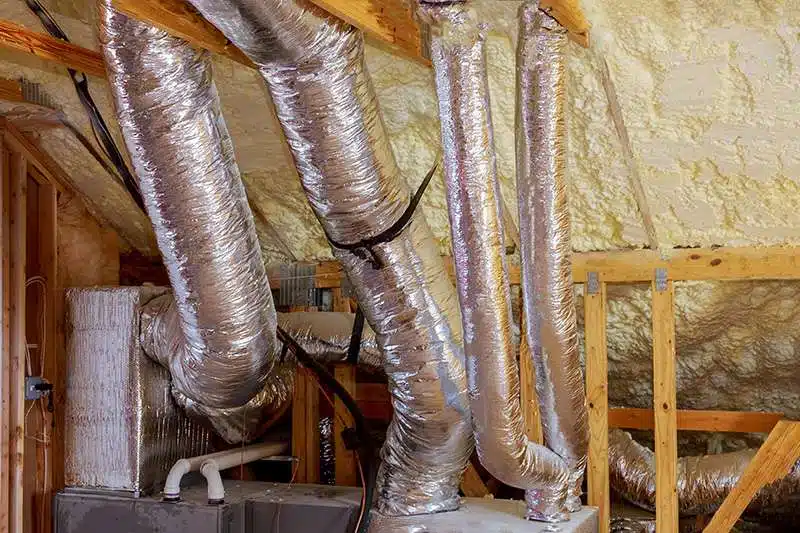
In the realm of heating, ventilation, and air conditioning (HVAC) systems, ductwork plays a pivotal role in ensuring optimal performance. Ductwork refers to the network of channels responsible for distributing air throughout a building, whether it’s a residential home or a commercial establishment. Understanding the significance of ductwork entails grasping its vital function within HVAC systems.
Ductwork acts as the conduit through which conditioned air travels from the HVAC unit to various rooms within a building. Properly designed and installed ductwork ensures smooth airflow, allowing for efficient heating or cooling of indoor spaces.
Apart from facilitating airflow, ductwork also ensures that conditioned air is evenly distributed throughout the building. This uniform distribution helps maintain consistent temperatures across different rooms, enhancing comfort levels for occupants.
The size and design of ductwork significantly impact its efficiency. Proper sizing is crucial to prevent airflow restrictions, while a well-thought-out design minimizes bends and turns that can impede airflow.
The material used for ductwork construction also influences its performance. Opting for high-quality materials resistant to corrosion and wear ensures longevity and sustained efficiency.
Even the best-designed ductwork can underperform if not installed correctly. Poor installation can lead to leaks, gaps, or inadequate insulation, all of which compromise airflow efficiency.
Maintaining optimal airflow through well-maintained ductwork is key to maximizing energy efficiency. Efficient airflow reduces the workload on HVAC systems, leading to lower energy consumption and decreased utility bills.
Proper airflow distribution ensures consistent temperatures throughout a building, enhancing occupant comfort. Maintaining optimal airflow helps prevent hot or cold spots, providing a more pleasant indoor environment.
Uneven temperatures across different rooms indicate potential ductwork issues. If certain areas of a building receive inadequate heating or cooling, it may signal airflow restrictions or leaks within the ductwork.
A sudden spike in energy bills without a corresponding increase in usage could be indicative of ductwork problems. Air leaks or blockages force HVAC systems to work harder, leading to higher energy consumption and elevated utility costs.
Ductwork issues can also affect indoor air quality. Leaky ducts may draw in pollutants from attics, crawl spaces, or wall cavities, circulating them throughout the building and compromising indoor air quality.
Scheduled inspections and cleanings help identify and address potential ductwork issues before they escalate. Removing dust, debris, and microbial growth from ducts improves airflow and indoor air quality.
Sealing leaks and gaps in ductwork prevents conditioned air from escaping into unconditioned spaces. Proper sealing enhances energy efficiency and ensures maximum airflow to occupied areas.
Insulating ductwork in unconditioned spaces such as attics or crawl spaces prevents heat gain or loss, preserving the temperature of conditioned air as it travels through the ducts.
Periodic professional inspections are essential for detecting hidden ductwork problems and ensuring optimal performance. HVAC technicians can identify issues such as leaks, blockages, or inadequate insulation and provide timely solutions.
In cases of significant ductwork damage or deterioration, professional repair or replacement may be necessary. HVAC experts can assess the extent of the damage and recommend appropriate repair or replacement options to restore optimal airflow.
Ductwork plays a critical role in maintaining optimal airflow for efficient HVAC performance. From facilitating airflow and ensuring proper distribution to maximizing energy efficiency and enhancing indoor comfort, well-maintained ductwork is indispensable for a functional HVAC system. Regular inspection, cleaning, and professional maintenance are essential to preserving ductwork efficiency and prolonging the lifespan of HVAC systems.
Ideally, ductwork should be inspected and cleaned every 3 to 5 years. However, homes with pets, smokers, or residents with allergies may require more frequent maintenance.
While minor ductwork leaks may be patched DIY using duct tape or mastic sealant, significant leaks or extensive damage should be addressed by professional HVAC technicians for lasting repairs.
Duct sealing prevents conditioned air from escaping, improving energy efficiency and comfort levels. Insulating ductwork minimizes heat gain or loss, preserving the temperature of conditioned air as it travels through the ducts.
Regular ductwork inspections and cleanings help remove accumulated dust, debris, and microbial growth, enhancing indoor air quality and reducing allergen exposure.
Yes, even in newly constructed buildings, ductwork maintenance is essential to ensure optimal performance and efficiency. Inspections can identify any installation issues or defects that may affect airflow and HVAC performance.

Expert HVAC solutions keeping your South Florida home or business comfortable year-round.